Why cut onions when planting before winter and whether it is necessary to do it
Many gardeners prefer to plant onion crops before winter in order to get a harvest earlier next year. This method requires some preparation of the planting material - in particular, trimming the bulbs. However, not all farmers know why this procedure is carried out and whether it is worth doing.
The article will tell you if you need to crop onion when planting before winter and how to properly prepare it for disembarkation.
The content of the article
Advantages and disadvantages of planting onions before winter
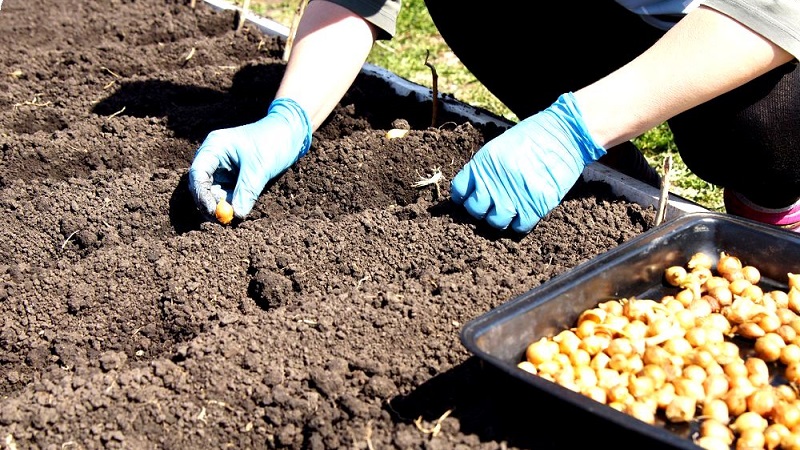
The autumn period is not the busiest in terms of caring for crops in the garden, so you should pay attention to the preparation of planting material. Onions are an unpretentious crop that can be planted not only in spring, but also in winter or late autumn.
Advantages and disadvantages winter landing are presented in the table.
| Benefits | disadvantages |
| Winter plantings begin to sprout 3 weeks earlier than spring crops, harvesting time falls on June-July | Difficulty in determining the timing of landing:
|
| After harvesting winter onions, there is a place for planting other crops | It is necessary to cover the beds for the winter |
| When planting shallow sevka, shooting does not occur | The planting rate should be 10-15% more than the base one, taking into account freezing in winter |
| In autumn, there are no pests and fungal diseases (rot, powdery mildew), you do not have to spray vegetables from onion flies and other insects | Late plantings always freeze |
| Planting in winter allows you to harvest a larger and better crop than when planting in spring | Improper pruning and preparation of vegetables spoils them |
| Onions planted in winter are stored for a year | Spring onions are stored better and longer than winter onions |
How to choose a place on the site for winter landing
The place for planting onions in the winter must meet the following parameters:
- loose soil;
- neutral reaction, pH about 6.0, 6.4-7.9 allowed;
- the place is well lit and ventilated, not under trees or a fence;
- high so that the water does not stagnate.
It is best to plant onions where the snow melts faster each year.
Reference. You can check the pH with litmus paper, which is sold in gardening stores. If the soil is acidic, apply lime in proportions of 250 g per 1 m².
Crop rotation and predecessors
The crop rotation rule speaks of the need to alternate crops, their combinations in the same bed.
The main principle - Onions have not been planted in the same place for more than 2 years in a row. Violation of this rule will lead to the accumulation of onion flies and fungi in the garden.
Particular attention is paid to previous cultures.
For winter onions:
- positive for growth and development - beets, peas, rapeseed, corn, lettuce, mustard, cucumbers;
- negative for growth and development - potatoes, legumes, parsley, celery, alfalfa.
Preparing the garden

After choosing a place for winter onions, beds are formed. Soil preparation begins in September. It is more effective to dig up the area under the bow than to process it with a walk-behind tractor. After loosening, the soil is given time to settle and compact.
Then fertilizer is applied, for example, humus (5-6 kg per 1 m²), mineral mixtures.
Furrows make deep 5-10 cm or the width of the palm, with the expectation that the earth will be covered with a mound on top.
Before planting, ash is added to the garden at the rate of 200 g per 1 m².
Why cut the onion when planting before winter
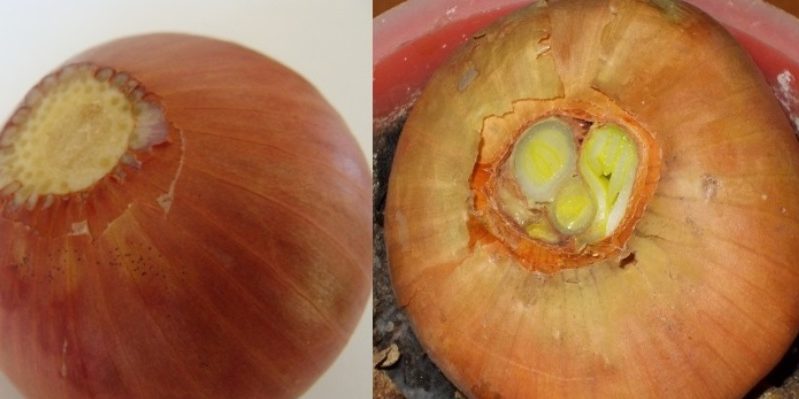
Before winter landing gardeners prepare onions in standard ways - soaking and pruning. This allows the bulbs to take root more firmly, not to rot in the ground, and also to accelerate germination and increase yields.
There are two pruning technologies, depending on the purpose:
- for growing greenery - cutting off the top by 1/3 of the onion;
- to get a turnip crop - trimming the dry tail of the seed (for fixing in the soil).
Most gardeners also advise cutting off the dry roots of the bulbs so that young roots germinate quickly.
Do I need to do this
Do I need to prune onions before planting in winter? Planting plants in the winter does not involve pruning in most cases - this technique increases the risk of bulb growth in the middle of winter. For bulbs, a good wintering will be provided by insulation and shelter from snow and cold winds. However, with proper care and a favorable climate, cutting the bulbs is permissible: if the seedlings do not die, then the yield will be much higher.
How to properly trim onions
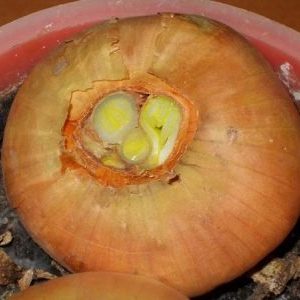 The main rule for trimming the bulbs is not to damage the seedling. For an illustrative example, you can cut one onion and study it.
The main rule for trimming the bulbs is not to damage the seedling. For an illustrative example, you can cut one onion and study it.
The germ sprout is located in the neck of the bulb, and it is very easy to cut it off with it, but then the vegetable will not sprout.
Council. For medium-sized onions, use a spring pruner, and a knife for large vegetables.
Bulbs are prepared in one of three ways:
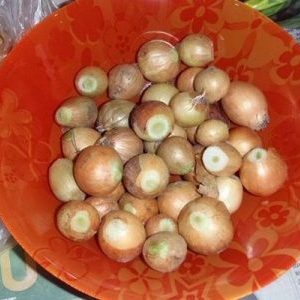
- on small onions, an incision is made in the upper part;
- on large, the upper part is cut by 1/3;
- divide the bulbs lengthwise into two parts.
Top trimming procedure
Feather Trimming:
- choose large heads;
- with a sharp tool, remove 1/3 of the onion at the top.
Pruning a turnip crop:
- choose small and medium heads;
- cut off the tails.
Do I need to cut the tails of the onion set
For winter planting of onions, tails are usually cut off. You cannot cut off the top under the feather, otherwise the head will freeze.
Preparation of planting material
Planting material for winter onions is prepared in stages:
- sorting;
- soak;
- pruning.
Sorting excludes diseased and damaged heads from the planting material, separates the bulbs by size. The first planting category consists of onions with a diameter of 1 to 1.5 cm.The second planting category includes heads from 1.5 to 3 cm.
If small onions remain (oat, with a diameter of less than 1 cm), then they are harvested, they are not suitable for winter harvest. Larger bulbs can be cut in half by cutting lengthwise.
Processing and soaking
After the separation of rotten and damaged onions, the planting ones are soaked 10-20 minutes before planting. A solution is suitable for this:
- 1 tbsp. l. table salt;
- 1 liter of water.
A solution of copper sulfate is also used: 1-1.5 tbsp is added to 10 liters of warm water. l. copper sulfate. Soaking time is 2-3 hours.
The traditional method of disinfection involves long-term soaking in a weak solution of potassium permanganate (about 6 hours). After such processing, drying of the bulbs is required.
Landing rules
The onions are planted 25 days before the onset of frost, so that it has time to take root. The average daily temperature of the day of planting is about + 5 ° C. For the southern regions this is the end of October - early November, for central Russia - October.
The optimal size of planting material - heads from 1 to 3 cm.
Onions are planted before winter according to the following technology:
- The soil is loosened and furrows are made.
- Before winter, they are planted in rows or in the form of nests, 3-4 pcs.
- The sowing is deepened to a depth of 2-3 cm or 4-6 cm (for large heads), the interval between them is 10 cm, and the distance between the rows is 15-20 cm.
- The bulbs are placed vertically in the ground with the root down, slightly squeezed with fingers, sprinkled with soil or humus.
- Water the soil if it was dry.
- Insulate the soil with organic material (fallen leaves, hay, legume waste). Spruce branches or branches are laid on top to protect from the wind and retain snow. For shelter, it is impossible to use a film, as well as fine organic matter (peat, sawdust).
Winter onion care
Winter onion garden care includes:
- fertilization;
- insulation from snow and cold wind (leaves, straw, small branches);
- in winter, shoveling snow onto the bed, which creates an air cushion and shelters young feathers from wind and frost;
- in the spring, removing the covering material and loosening the soil;
- watering if necessary in spring.
Fertilizers
Fertilize onions three times:
- a week before planting, 15-20 g per 1 m² of lowland peat are introduced into the soil;
- potassium sulfate is added on the day of planting (5-8 g per 1 m²);
- during planting, ash is introduced into the furrow.
Tips from experienced gardeners
To get a good harvest, experienced gardeners recommend: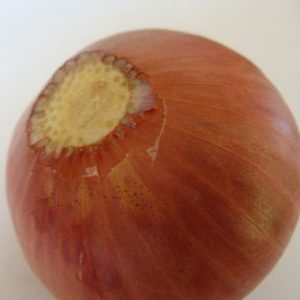
- store planting material in a dry place with good ventilation;
- thin out dense seedlings to an interval of 5-6 cm;
- do not fertilize the soil with fresh manure;
- use joint planting (in the spring, plant calendula, marigolds, carrots next to onions to protect crops from pests);
After harvesting winter onions, it is advised to sow beets, turnips, daikon, radish or greens to get the harvest of other crops.
Conclusion
Planting onions in winter gives a harvest of strong bulbs that will last throughout the year. Particular attention is paid to the preparation of the soil and planting material.
In particular, many gardeners cut the onion, although this procedure can lead to the death of the set in the event of severe frosts. However, under favorable weather conditions, pruning will only benefit the plants.